Butterflies and Moths
Media
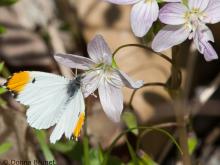
Species Types
Scientific Name
Anthocharis midea
Description
Falcate orangetip males are unmistakable with their small size, white coloration, and orange wingtips. Look for them in open woodlands in April.
Media
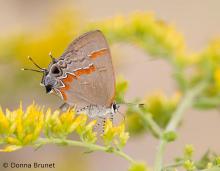
Species Types
Scientific Name
Calycopis cecrops
Description
The red-banded hairstreak has a unique pattern of white, black, and red-orange bands on the underside hindwing. It is most common in the Ozarks.
Media
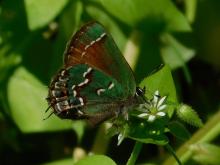
Species Types
Scientific Name
Callophrys gryneus gryneus (syn. Mitoura gryneus gryneus)
Description
The only green butterfly in Missouri, the olive (or juniper) hairstreak never strays far from eastern red cedar, its larval food plant. Adults fly between April and August.
Media
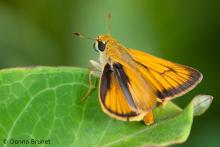
Species Types
Scientific Name
Anatrytone logan
Description
The undersides of the Delaware skipper's wings are solid orange. It's found statewide in a variety of habitats.
Media
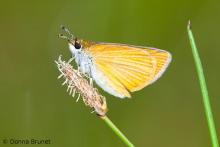
Species Types
Scientific Name
Ancyloxypha numitor
Description
One of the smallest skippers in the eastern United States, the least skipper is found in moist, grassy areas, usually near water.
Media

Species Types
Scientific Name
Polites peckius
Description
Peck’s skipper is found in Missouri’s fields, lawns, and other open habitats from May through October. Identify it by the one yellow hindwing rectangle that is wider than the others.
Media
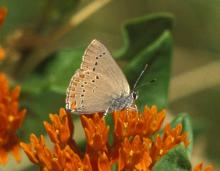
Species Types
Scientific Name
Satyrium titus (syn. Harkenclenus titus)
Description
The coral hairstreak is the only Missouri hairstreak lacking hindwing “tails” and without a blue spot on the outer hindwing edge.
Media
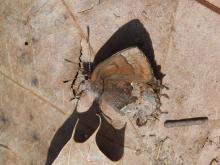
Species Types
Scientific Name
Callophrys henrici (formerly Incisalia henrici)
Description
Henry’s elfin is a small brown butterfly with splendid camouflage markings. It lives in and near open woodlands. The adults fly only in April and early May, when redbuds and wild plums are blooming.
Media

Species Types
Scientific Name
Euphydryas phaeton ozarkae
Description
The Baltimore checkerspot is unforgettable. In Missouri it is locally abundant in the eastern Ozarks, but rare elsewhere.
Media

Species Types
Scientific Name
Junonia coenia
Description
The common buckeye is one of Missouri’s prettiest butterflies, but it doesn’t overwinter here. Instead, migrants arrive in late spring and early summer.
See Also


Media

Species Types
Scientific Name
About 1,500 species in North America north of Mexico
Description
Adult caddisflies are mothlike. Their larvae are aquatic and build portable, protective cases out of local materials, including grains of sand, bits of leaves and twigs, and other debris.
Media

Species Types
Scientific Name
Corydalus cornutus
Description
Adult eastern dobsonflies are huge and mothlike, with large wings and a weak, fluttery flight. The fiercely predaceous aquatic larvae, called hellgrammites, are well-known to anglers, who often use them as bait.
About Butterflies and Moths in Missouri
Butterflies, skippers, and moths belong to an insect order called the Lepidoptera — the "scale-winged" insects. These living jewels have tiny, overlapping scales that cover their wings like shingles. The scales, whether muted or colorful, seem dusty if they rub off on your fingers. Many butterflies and moths are associated with particular types of food plants, which their caterpillars must eat in order to survive.





















